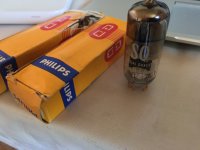Thank you for your offer !
I hope to get D3a from a friend, otherwise will start to mail people on diyaudio.
Is good to know that some of you still have these. Thanks !
Here is latest HMS power supply version that include a small correction on 160V and 260V. These have been reverse marked. Also a small correction on R27 (on PCB R7). The value that worked for me, and I see for others too, is 6k6. So. I marked this on PCB R7=6k6*
Regards,
Tibi
I hope to get D3a from a friend, otherwise will start to mail people on diyaudio.
Is good to know that some of you still have these. Thanks !
Here is latest HMS power supply version that include a small correction on 160V and 260V. These have been reverse marked. Also a small correction on R27 (on PCB R7). The value that worked for me, and I see for others too, is 6k6. So. I marked this on PCB R7=6k6*
Regards,
Tibi
Attachments
... and the winner is ...
First I will thank SY for such superb design.
I think a more appropriate name would be "The master of noise".
This phono is indeed noise free.
My implementation is dual mono with two transformers with three secondaries, 240V, 9V, 9V.
Rectification with ideal rectifiers, Saligny HVHF for high voltage and Saligny LC for heaters section.
The boards I have designed do not include rectifier and ballast coil. As soon I have time I will modify this.
There is also a small modification on heater that must be corrected as well.
Tubes used are Philips d3A and JJ E88CC.
System used: Rega Planar 1 with Hana EH, amplifier Quasar Q17 with High Density speaker cables.
Regards,
Tibi
First I will thank SY for such superb design.
I think a more appropriate name would be "The master of noise".
This phono is indeed noise free.
My implementation is dual mono with two transformers with three secondaries, 240V, 9V, 9V.
Rectification with ideal rectifiers, Saligny HVHF for high voltage and Saligny LC for heaters section.
The boards I have designed do not include rectifier and ballast coil. As soon I have time I will modify this.
There is also a small modification on heater that must be corrected as well.
Tubes used are Philips d3A and JJ E88CC.
System used: Rega Planar 1 with Hana EH, amplifier Quasar Q17 with High Density speaker cables.
Regards,
Tibi
Attachments
-
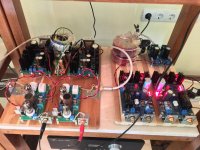 phono.jpeg376 KB · Views: 459
phono.jpeg376 KB · Views: 459 -
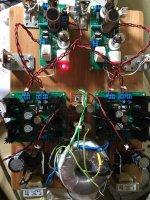 signal-2020-08-22-185031_001.jpeg346.8 KB · Views: 309
signal-2020-08-22-185031_001.jpeg346.8 KB · Views: 309 -
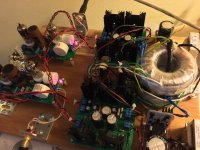 signal-2020-08-22-185031_002.jpeg324.7 KB · Views: 279
signal-2020-08-22-185031_002.jpeg324.7 KB · Views: 279 -
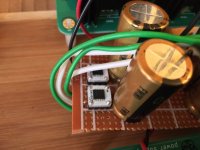 signal-2020-08-22-185031_003.jpeg235.8 KB · Views: 251
signal-2020-08-22-185031_003.jpeg235.8 KB · Views: 251 -
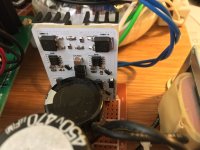 signal-2020-08-22-185031_004.jpeg260.1 KB · Views: 243
signal-2020-08-22-185031_004.jpeg260.1 KB · Views: 243 -
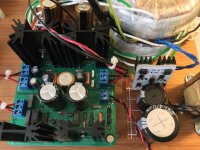 signal-2020-08-22-185031_005.jpeg328.2 KB · Views: 255
signal-2020-08-22-185031_005.jpeg328.2 KB · Views: 255 -
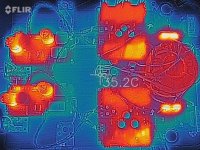 signal-2020-08-22-185031_006.jpeg98.6 KB · Views: 267
signal-2020-08-22-185031_006.jpeg98.6 KB · Views: 267
Last edited by a moderator:
It's only theoretical lower noise as you can't really hear anything with a resistor in d3a's cathode , but a 68 ohm cathode resistor instead will get you some audible distortion improvment over the LED.Although Sy wanted the lowest noise possible in his design 16ma anode current is better used instead of 20ma for d3a to run longer , so a 75 ohm resistor will fit the bill. If everything designed properly that won't get you any audible noise.Unfortunately you need a considerable number of d3a tubes to find two having about the same Vgs/Ia so a wirewound potentiometer might be the key for easily calibrating both D3A.The current source is setting the current anyway, but the resistor does a wonderful job at reducing distortions.I myself never used a current source, i went for a voltage source instead, but keeping the current source at 20ma and the cathode resistor at 16ma should work very well.
Last edited:
Here a sound sample https://twitter.com/i/status/1297209874389098498
Twitter did some nasty compression there, but still...
Regards,
Tibi
Twitter did some nasty compression there, but still...
Regards,
Tibi
the camera that recorded has its own compressor and it's quite powerful and the recording itself has a lot of echo.Very difficult for assessing the music through this kind of recordings, unless it's recorded straight from the preamp output .Would you just try a 75 ohms cathode resistor and tell us if you could hear any difference.At least i am curious if the current source is acting more on distortions than it does the resistor when d3a anode has a voltage source feeding it.
Last edited:
Thanks Jeff !
I love this phono, it adds a new dimension to sound.
Here is a direct comparison between Salas simplistic folded and HMN.
Again twitter compression is strong, but you can still hear a clear difference between two.
https://twitter.com/tiberiu_vicol/status/1297221720710033415
https://twitter.com/tiberiu_vicol/status/1297219358629015558
Regards,
Tibi
I love this phono, it adds a new dimension to sound.
Here is a direct comparison between Salas simplistic folded and HMN.
Again twitter compression is strong, but you can still hear a clear difference between two.
https://twitter.com/tiberiu_vicol/status/1297221720710033415
https://twitter.com/tiberiu_vicol/status/1297219358629015558
Regards,
Tibi
Here is a direct comparison between Salas simplistic folded and HMN.
Again twitter compression is strong, but you can still hear a clear difference between two.
You've really got the Salas cranked up compared to the HMN. Would be nice if you could match the levels.
jeff
I have removed twitter posts as there is a huge compression and this add distortion.
I'll load original files to some sharing server.
I love the Salas phono. It is well designed and sound good.
HMN is in another league. Timbre is different, better clarity, separation, huge soundstage, top spectrum is diamond clear, bass is round and precise.
To my ears and not only, HMN is a clear winner.
Regards,
Tibi
I'll load original files to some sharing server.
I love the Salas phono. It is well designed and sound good.
HMN is in another league. Timbre is different, better clarity, separation, huge soundstage, top spectrum is diamond clear, bass is round and precise.
To my ears and not only, HMN is a clear winner.
Regards,
Tibi
Last edited by a moderator:
Thanks Brinkman !
Pink Martini - Storm - Album: Dream a little dream
Storm, a song by Pink Martini, The Von Trapps on Spotify
Regards,
Tibi
Pink Martini - Storm - Album: Dream a little dream
Storm, a song by Pink Martini, The Von Trapps on Spotify
Regards,
Tibi
Hi,
I'd like to ask about capacitors for C12 and C16, input to the regulator IC's at 0.1uF. LM317 data sheets says ceramic, LM337 says solid tantalum. Can anyone please suggest how critical this is, or even better, what is the 'best' type to use for use in this circuit.
Also somewhat related, what is the impact of using 100uF+ in lieu of the usual 10uF from ADJ to 0V.
Thank you
J. Peterman
I'd like to ask about capacitors for C12 and C16, input to the regulator IC's at 0.1uF. LM317 data sheets says ceramic, LM337 says solid tantalum. Can anyone please suggest how critical this is, or even better, what is the 'best' type to use for use in this circuit.
Also somewhat related, what is the impact of using 100uF+ in lieu of the usual 10uF from ADJ to 0V.
Thank you
J. Peterman
Last edited:
I have removed twitter posts as there is a huge compression and this add distortion.
I'll load original files to some sharing server.
I love the Salas phono. It is well designed and sound good.
HMN is in another league. Timbre is different, better clarity, separation, huge soundstage, top spectrum is diamond clear, bass is round and precise.
To my ears and not only, HMN is a clear winner.
Regards,
Tibi
Is there a chance your FSP was set somewhat gainy on your cartridge? Possibly bit overloading? There is also the Valve Itch I had compared it to. At its best with rare Soviet 6N2P gold grid large triple mica on input stage and rarest Soviet 1578 at the output. The two designs do sound different as JFET vs Triode based would, but not incomparably different. The Itch is insensitive to proper gain with cartridge though due to high voltage B+
At the time of comparison, HMN had higher gain, so FSP was for sure not overloaded. In fact FSP was set at lowest gain for a MC cartridge with 2mV max output.
FSP sounded very good and it was the one that set me to look for more.
Initially I have tested HMN with JJ E88CC. Later with Genelex 6922. In the end I settle at the 6N23P which is a fantastic tube.
Beside sound difference, there is a cost difference as well.
To build HMN final cost was almost 2000euro.
To build FSP final cost was ~350euro.
So FSP is a great phono that offer fantastic value for the price.
Regards.
Tibi
FSP sounded very good and it was the one that set me to look for more.
Initially I have tested HMN with JJ E88CC. Later with Genelex 6922. In the end I settle at the 6N23P which is a fantastic tube.
Beside sound difference, there is a cost difference as well.
To build HMN final cost was almost 2000euro.
To build FSP final cost was ~350euro.
So FSP is a great phono that offer fantastic value for the price.

Regards.
Tibi
Last edited by a moderator:
Hi,
I'd like to ask about capacitors for C12 and C16, input to the regulator IC's at 0.1uF. LM317 data sheets says ceramic, LM337 says solid tantalum. Can anyone please suggest how critical this is, or even better, what is the 'best' type to use for use in this circuit.
Also somewhat related, what is the impact of using 100uF+ in lieu of the usual 10uF from ADJ to 0V.
Thank you
J. Peterman
the 10uF at that point is to reduce noise and lower the output impedance of the regulator. In fact it's not necessary at all as the filaments draw a constant current which obviates the need of LowZ regulator. Gilding the lily if you ask me.
C12 and C16 -- only if the regulator is more than a few inches from its supply. Ceramics are fine, and when tantalums fail, they fail spectacularly.
the 10uF at that point is to reduce noise and lower the output impedance of the regulator. In fact it's not necessary at all as the filaments draw a constant current which obviates the need of LowZ regulator. Gilding the lily if you ask me.
C12 and C16 -- only if the regulator is more than a few inches from its supply. Ceramics are fine, and when tantalums fail, they fail spectacularly.
Thank you, will use what I have on hand - 10uF at ADJ. If C12 and C16 are somewhat flexible, okay to use 0.1uF MKP?.
J. Peterman
sure!Thank you, will use what I have on hand - 10uF at ADJ. If C12 and C16 are somewhat flexible, okay to use 0.1uF MKP?.
- Home
- General Interest
- diyAudio.com Articles
- His Master's Noise: A Thoroughly Modern Tube Phono Preamp
